Exploring Herbaceous Plant Biodiversity Design in Chinese Rain Gardens: A Literature Review
Abstract
1. Introduction
- (1)
- Conducting a comprehensive examination of herbaceous species selection in rain gardens across diverse environmental conditions. Emphasis will be placed on meeting local requirements while minimizing maintenance costs, ensuring sustainability, maximizing taxonomic diversity, showcasing seasonal variations, and supporting wildlife.
- (2)
- Optimizing the configuration of herbaceous plants in urban rain gardens to fulfill multiple functional requirements, including flood prevention, aesthetic enhancement, facilitation of ecologically sustainable urban development, and improving urban residents’ quality of life.
- (3)
- Identifying shortcomings in the current arrangement of herbaceous plants in Chinese urban rain gardens. This analysis will provide a robust theoretical foundation for future rain garden design in regions with similar climates and environmental conditions.
2. Methods
2.1. Research Structure
2.2. Literature Review
2.3. Case Study Analysis
3. Results and Discussion
3.1. Literature Review
3.1.1. Issues and Causes of Stormwater Management in China
3.1.2. Response to Urban Stormwater Challenges
3.1.3. Strategies for Enhancing Herbaceous Plant Diversity
3.1.4. Rain Garden Overview
3.1.5. Herbaceous Plant Selection and Design for Chinese Rain Gardens
3.2. Case Studies
3.2.1. Rain Garden at Beijing’s 768 Creative Park: An Urban Sustainability Project
3.2.2. Rain Garden at Huazhong University of Science and Technology: Project Yuyun
3.2.3. The Gongkang Rain Garden in Shanghai
3.2.4. Rain Garden along Qinhuang Avenue
3.2.5. Advantages and Disadvantages of Herbaceous Planting Design in Chinese Rain Gardens
3.3. Integrating Ecological Principles in Herbaceous Planting Design for Chinese Rain Gardens
- (1)
- (2)
- Carefully contemplate the niche characteristics of species when choosing and organizing herbaceous plants in rain gardens to mitigate adverse effects on their growth caused by excessive competition for space and nutrients among species [111]. The paramount objective should be to enrich the ecological environment, reduce rainwater runoff and pollution, and establish a resilient plant community predominantly comprised of native herbs [67].
- (3)
- From a landscape perspective, the herbaceous plant arrangement in rain gardens should be scientifically and thoughtfully designed, incorporating plants that reflect specific cultural connotations to create visually striking urban landscapes with humanistic characteristics [67]. Factors such as flowering periods, colors, shapes, textures, and seasonal variations of herbaceous plants should be considered. Additionally, planting them alongside woody plants can enhance the vegetation community’s structural complexity and aesthetic appeal [63].
- (4)
4. Conclusions and Recommendations
Author Contributions
Funding
Data Availability Statement
Acknowledgments
Conflicts of Interest
References
- Singh, R.L.; Singh, P.K. Global environmental problems. In Principles and Applications of Environmental Biotechnology for a Sustainable Future; Springer: Berlin/Heidelberg, Germany, 2017; pp. 13–41. [Google Scholar]
- Yuan, J. Investigating The Planting Potential For Urban Rain Gardens: Plant Selection, Establishment and Performance. Ph.D. Thesis, University of Sheffield, Sheffield, UK, 2016. [Google Scholar]
- Grimm, N.B.; Faeth, S.H.; Golubiewski, N.E. Global change and the ecology of cities. Science 2008, 319, 756–760. [Google Scholar] [CrossRef] [PubMed]
- Kumar, P. Climate change and cities: Challenges ahead. Front. Sustain. Cities 2021, 3, 645613. [Google Scholar] [CrossRef]
- Güneralp, B.; Güneralp, İ.; Liu, Y. Changing global patterns of urban exposure to flood and drought hazards. Glob. Environ. Chang. 2015, 31, 217–225. [Google Scholar] [CrossRef]
- Brown, R.R. Impediments to integrated urban stormwater management: The need for institutional reform. Environ. Manag. 2005, 36, 455–468. [Google Scholar] [CrossRef] [PubMed]
- Kenway, S.J.; Lant, P. The influence of water on urban energy use. Water Sensitive Cities 2012, 63–77. [Google Scholar]
- Cameron, R.; Hitchmough, J. Environmental Horticulture Science and Management of Green Landscapes; Cabi: Wallingford, UK, 2016. [Google Scholar]
- Daniels, B.J.; Yeakley, J.A. Catchment-Scale Hydrologic Effectiveness of Residential Rain Gardens: A Case Study in Columbia, Maryland, USA. Water 2024, 16, 1304. [Google Scholar] [CrossRef]
- Doğmuşöz, B.B. Plant selection for rain gardens in temperate climates: The case of Izmir, Turkey. J. Des. Resil. Archit. Plan. 2024, 5, 18–34. [Google Scholar] [CrossRef]
- Dunnett, N.; Clayden, A. Rain Gardens, Managing Water Sustainably in the Garden and Designed Landscape; Timber Press: London, UK, 2007. [Google Scholar]
- Steiner, L.M.; Domm, R.W. Rain Gardens: Sustainable Landscaping for a Beautiful Yard and a Healthy World; Voyageur Press: Minneapolis, MN, USA, 2012. [Google Scholar]
- Pickett, S.T.A.; Cadenasso, M.L. Linking ecological and built components of urban mosaics: An open cycle of ecological design. J. Ecol. 2008, 96, 8–12. [Google Scholar] [CrossRef]
- Huang, H. Plant diversity and conservation in China: Planning a strategic bioresource for a sustainable future. Bot. J. Linn. Soc. 2011, 166, 282–300. [Google Scholar] [CrossRef]
- Turner, M.N. Framework for Reconciliation: Adapting an Urban Park to Welcome Little Brown Bats (Myotis lucifugus). Ph.D. Thesis, University of Georgia, Athens, GA, USA, 2017. [Google Scholar]
- El-Haggar, S.; Samaha, A.; El-Haggar, S.; Samaha, A. Sustainable urban community development guidelines. In Roadmap for Global Sustainability—Rise of the Green Communities; Springer: Cham, Switzerland, 2019; pp. 75–102. [Google Scholar]
- Preston, S. Examining the Role of Community Engagement in Nature-Based Solutions. Ph.D. Thesis, The University of Liverpool, Liverpool, UK, 2020. [Google Scholar]
- Vargas-Hernández, J.G.; Pallagst, K.; Hammer, P. Strategic management innovation of urban green spaces for sustainable community development. Handb. Engaged Sustain. 2018, 2, 917–944. [Google Scholar]
- Yu, K.J. Sponge City—Ideas and Methods. Constr. Sci. Technol. 2019, 377, 10–11. [Google Scholar]
- Mishra, A.; Mukherjee, S.; Merz, B.; Singh, V.P.; Wright, D.B.; Villarini, G.; Paul, S.; Kumar, D.N.; Khedun, C.P.; Niyogi, D.; et al. An overview of flood concepts, challenges, and future directions. J. Hydrol. Eng. 2022, 27, 03122001. [Google Scholar] [CrossRef]
- Griffiths, J.; Chan, F.K.S.; Shao, M.; Zhu, F.; Higgitt, D.L. Interpretation and application of Sponge City guidelines in China. Philos. Trans. R. Soc. A 2020, 378, 20190222. [Google Scholar] [CrossRef] [PubMed]
- Huang, Y.; Lin, J.; He, X.; Lin, Z.; Wu, Z.; Zhang, X. Assessing the scale effect of urban vertical patterns on urban waterlogging: An empirical study in Shenzhen. Environ. Impact Assess. Rev. 2024, 106, 107486. [Google Scholar] [CrossRef]
- Leopold, L.B. Hydrology for Urban Land Planning: A Guidebook on the Hydrologic Effects of Urban Land Use; US Geological Survey: Washington, DC, USA, 1968; Volume 3, p. 18. [Google Scholar]
- Santamouris, M. Using Cool Pavements as a Mitigation Strategy to Fight Urban Heat Island—A Review of the Actual Developments. Renew. Sustain. Energy Rev. 2013, 26, 224–240. [Google Scholar] [CrossRef]
- Edmondson, J.L.; Stott, I.; Davies, Z.G.; Gaston, K.J.; Leake, J.R. Soil Surface Temperatures Reveal Moderation of the Urban Heat Island Effect by Trees and Shrubs. Sci. Rep. 2016, 6, 2045–2322. [Google Scholar] [CrossRef] [PubMed]
- Siwiec, E.; Erlandsen, A.; Vennemo, H. City greening by rain gardens-costs and benefits, Environmental Protection and Natural Resources. J. Inst. Environ. Prot. Natl. Res. Inst. 2018, 29, 1–5. [Google Scholar]
- Liu, J.; Sample, D.J.; Bell, C.; Guan, Y. Review and research needs of bioretention used for the treatment of urban stormwater. Water 2014, 6, 1069–1099. [Google Scholar] [CrossRef]
- Alberti, M.; Booth, D.; Hill, K.; Coburn, B.; Avolio, C.; Coe, S.; Spirandelli, D. The impact of urban patterns on aquatic ecosystems: An empirical analysis in Puget lowland sub-basins. Landsc. Urban Plan. 2007, 80, 345–361. [Google Scholar] [CrossRef]
- Carey, R.O.; Hochmuth, G.J.; Martinez, C.J.; Boyer, T.H.; Dukes, M.D.; Toor, G.S.; Cisar, J.L. Evaluating nutrient impacts in urban watersheds: Challenges and research opportunities. Environ. Pollut. 2013, 173, 138–149. [Google Scholar] [CrossRef]
- Hatt, B.E.; Steinel, A.; Deletic, A.; Fletcher, T.D. Retention of heavy metals by stormwater filtration systems: Breakthrough analysis. Water Sci. Technol. 2011, 64, 1913–1919. [Google Scholar] [CrossRef] [PubMed]
- Wang, Y.; Zheng, C.; Ma, R. Safe and sustainable groundwater supply in China. Hydrogeol. J. 2018, 26, 1301–1324. [Google Scholar] [CrossRef]
- Browder, J.G.; Xie, S.Q.; Kim, Y.; Gu, L.X.; Fan, M.Y.; Ehrhardt, D. Stepping up: Improving the Performance of China’s Urban Water Utilities; The World Bank: Washington, DC, USA, 2007. [Google Scholar]
- Cramer, W.; Guiot, J.; Fader, M.; Garrabou, J.; Gattuso, J.-P.; Iglesias, A.; Lange, M.A.; Lionello, P.; Llasat, M.C.; Paz, S.; et al. Climate change and interconnected risks to sustainable development in the Mediterranean. Nat. Clim. Chang. 2018, 8, 972–980. [Google Scholar] [CrossRef]
- Kumar, A.; Nagar, S.; Anand, S. Climate change and existential threats. In Global Climate Change; Elsevier: Amsterdam, The Netherlands, 2021; pp. 1–31. [Google Scholar]
- Watkiss, P.; Downing, T.; Handley, C.; Butterfield, R. The Impacts and Costs of Climate Change; European Commission DG Environment: Brussels, Belgium, 2005. [Google Scholar]
- Noguer, M.; van der Linden, P.J.; Dai, X.; Maskell, K.; Johnson, C.A. Climate Change 2001: The Scientific Basis; Houghton, J.T., Ding, Y.D.J.G., Griggs, D.J., Eds.; Cambridge University Press: Cambridge, UK, 2001. [Google Scholar]
- Kabisch, N.; Korn, H.; Stadler, J.; Bonn, A. Nature-Based Solutions to Climate Change Adaptation in Urban Areas: Linkages between Science, Policy and Practice; Springer Nature: London, UK, 2017. [Google Scholar]
- Lai, E.C. Climate Change Impacts on China’s Environment: Biophysical Impacts; Woodrow Wilson Center: Washington, DC, USA, 2009. [Google Scholar]
- Ahani, S.; Dadashpoor, H. Urban growth containment policies for the guidance and control of peri-urbanization: A review and proposed framework. Environ. Dev. Sustain. 2021, 23, 14215–14244. [Google Scholar] [CrossRef]
- Jiang, P.; Cheng, Q.; Gong, Y.; Wang, L.; Zhang, Y.; Cheng, L.; Li, M.; Lu, J.; Duan, Y.; Huang, Q.; et al. Using urban development boundaries to constrain uncontrolled urban sprawl in China. Ann. Am. Assoc. Geogr. 2016, 106, 1321–1343. [Google Scholar] [CrossRef]
- Wei, G.; He, B.J.; Sun, P.; Liu, Y.; Li, R.; Ouyang, X.; Luo, K.; Li, S. Evolutionary trends of urban expansion and its sustainable development: Evidence from 80 representative cities in the belt and road initiative region. Cities 2023, 138, 104353. [Google Scholar] [CrossRef]
- Yu, K.J.; Li, L. Alleviating waterlogging needs to build a ‘sponge city’. China Econ. Rep. 2016, 8, 52–55. [Google Scholar]
- Anonymous. Global Perspectives: Advanced Drainage Systems in Developed Countries. Urban Manag. Technol. 2013. [Google Scholar]
- Nguyen, T.T.; Ngo, H.H.; Guo, W.; Wang, X.C.; Ren, N.; Li, G.; Ding, J.; Liang, H. Implementation of a specific urban water management-Sponge City. Sci. Total Environ. 2019, 652, 147–162. [Google Scholar] [CrossRef]
- Qi, Y.; Chan, F.K.S.; Thorne, C.; O’donnell, E.; Quagliolo, C.; Comino, E.; Pezzoli, A.; Li, L.; Griffiths, J.; Sang, Y.; et al. Addressing challenges of urban water management in Chinese sponge cities via nature-based solutions. Water 2020, 12, 2788. [Google Scholar] [CrossRef]
- Song, C. Application of nature-based measures in China’s sponge city initiative: Current trends and perspectives. Nat. Based Solut. 2022, 2, 100010. [Google Scholar] [CrossRef]
- Zhou, Q.; Ren, Y.; Xu, M.; Han, N.; Wang, H. Adaptation to urbanization impacts on drainage in the city of Hohhot, China. Water Sci. Technol. 2016, 73, 167–175. [Google Scholar] [CrossRef]
- Elmqvist, T.; Gatzweiler, F.; Lindgren, E.; Liu, J. Resilience management for healthy cities in a changing climate. Biodivers. Health Face Clim. Chang. 2019, 411–424. [Google Scholar]
- Nelson, V. Achieving the Water Commons—The Role of Decentralised Systems; IWA Publishing: London, UK, 2012; pp. 9–28. [Google Scholar]
- Albright, C.M. Resilience Strategies for Climate, Hydrology, and Urban Green Infrastructure; Villanova University: Villanova, PA, USA, 2018. [Google Scholar]
- Sun, Y.; Deng, L.; Pan, S.Y.; Chiang, P.C.; Sable, S.S.; Shah, K.J. Integration of green and gray infrastructures for sponge city: Water and energy nexus. Water-Energy Nexus 2020, 3, 29–40. [Google Scholar] [CrossRef]
- Chapman, C.M. Green and Grey Drainage Infrastructure: Costs and Benefits of Reducing Surface Water Flood Risk. Ph.D. Thesis, University of Oxford, Oxford, UK, 2023. [Google Scholar]
- Jiang, S.C.; Lim, K.Y.; Huang, X.; McCarthy, D.; Hamilton, A.J. Human and environmental health risks and benefits associated with use of urban stormwater. Wiley Interdiscip. Rev. Water 2015, 2, 683–699. [Google Scholar] [CrossRef]
- Arnold, C.L., Jr.; Gibbons, C.J. Impervious surface coverage: The emergence of a key environmental indicator. J. Am. Plan. Assoc. 1996, 62, 243–258. [Google Scholar] [CrossRef]
- Askarizadeh, A.; Rippy, M.A.; Fletcher, T.D.; Feldman, D.L.; Peng, J.; Bowler, P.; Jiang, S.C. From rain tanks to catchments: Use of low-impact development to address hydrologic symptoms of the urban stream syndrome. Environ. Sci. Technol. 2015, 49, 11264–11280. [Google Scholar] [CrossRef] [PubMed]
- Miles, B.; Band, L.E. Green infrastructure stormwater management at the watershed scale: Urban variable source area and watershed capacitance. Hydrol. Process. 2015, 29, 2268–2274. [Google Scholar] [CrossRef]
- Dudrick, R.; Hoffman, M.; Antoine, J.; Austin, K.; Bedoya, L.; Clark, S.; Gotsch, S.G. Do plants matter?: Determining what drives variation in urban rain garden performance. Ecol. Eng. 2024, 201, 107208. [Google Scholar] [CrossRef]
- Bąk, J.; Barjenbruch, M. Benefits, inconveniences, and facilities of the application of rain gardens in urban spaces from the perspective of climate change—A review. Water 2022, 14, 1153. [Google Scholar] [CrossRef]
- Dussaillant, A.R.; Wu, C.H.; Potter, K.W. Richards equation model of a rain garden. J. Hydrol. Eng. 2004, 9, 219–225. [Google Scholar] [CrossRef]
- Jia, Z.; Tang, S.; Luo, W.; Li, S.; Zhou, M. Small scale green infrastructure design to meet different urban hydrological criteria. J. Environ. Manag. 2016, 171, 92–100. [Google Scholar] [CrossRef] [PubMed]
- Han, J.W. Comprehensive evaluation of plant materials in Ya’an rainwater garden based on sponge city. J. Cent. South Univ. For. Technol. 2018, 39, 131–135. [Google Scholar]
- Chen, W. Selection and application of plants in rain gardens for Sponge City construction in Xiamen. Henan Build. Mater. 2018, 449–451. [Google Scholar]
- Oudolf, P.; Kingsbury, N. Planting: A New Perspective; Timber Press: London, UK, 2016. [Google Scholar]
- Burlando, P.; Vagge, I. The ‘Green’as Element of Regional Identity. ATTI 2020, 263–272. [Google Scholar]
- Hitchmough, J.; Dunnett, N. The Dynamic Landscape: Ecology, Design and Management of Urban Naturalistic Vegetation; Spon Press: London, UK, 2003. [Google Scholar]
- Hitchmough, J.; Wagner, M. The dynamics of designed plant communities of rosette forming forbs for use in supra urban drainage swales. Landsc. Urban Plan. 2013, 117, 122–134. [Google Scholar] [CrossRef]
- Hitchmough, J.; Dunnett, N. Landscaping in Sport Complex; Ecologically Based Planting Design at the 2012 London Olympics. MANZAR Sci. J. Landsc. 2012, 4, 14–19. [Google Scholar]
- Hitchmough, J.; Dunnett, N. Design and Planting Strategy in the Olympic Park, London. Flowering meadows around the Olympic sports facilities. Topos Eur. Landsc. Mag. 2013, 83. [Google Scholar]
- Kumar, A. Experimental Study of a Rain Garden. Ph.D. Thesis, National Institutes of Technology, Ajitgarh, India, 2019. [Google Scholar]
- Robinson, T.; Schulte-Herbrüggen, H.; Mácsik, J.; Andersson, J. Raingardens for Stormwater Management: Potential of Raingardens in a Nordic Climate; Swedish National Road and Transport Research Institute (VTI): Stockholm, Sweden, 2019. [Google Scholar]
- Caparrós-Martínez, J.L.; Milán-García, J.; Rueda-López, N.; de Pablo-Valenciano, J. Green infrastructure and water: An analysis of global research. Water 2020, 12, 1760. [Google Scholar] [CrossRef]
- Novotny, V. Sustainable urban water management. In Water and Urban Development Paradigms; CRC Press: Boca Raton, FL, USA, 2008; pp. 37–50. [Google Scholar]
- Kasprzyk, M.; Szpakowski, W.; Poznańska, E.; Boogaard, F.C.; Bobkowska, K.; Gajewska, M. Technical solutions and benefits of introducing rain gardens–Gdańsk case study. Sci. Total Environ. 2022, 835, 155487. [Google Scholar] [CrossRef]
- Malaviya, P.; Sharma, R.; Sharma, P.K. Rain gardens as stormwater management tool. In Sustainable Green Technologies for Environmental Management; Springer: Singapore, 2019; pp. 141–166. [Google Scholar]
- Sharma, R.; Malaviya, P. Management of stormwater pollution using green infrastructure: The role of rain gardens. Wiley Interdiscip. Rev. Water 2021, 8, e1507. [Google Scholar] [CrossRef]
- Morash, J.; Wright, A.; LeBleu, C.; Meder, A.; Kessler, R.; Brantley, E.; Howe, J. Increasing sustainability of residential areas using rain gardens to improve pollutant capture, biodiversity and ecosystem resilience. Sustainability 2019, 11, 3269. [Google Scholar] [CrossRef]
- Philp, M.; McMahon, J.; Heyenga, S.; Marinoni, O.; Jenkins, G.; Maheepala, S.; Greenway, M. Review of stormwater harvesting practices. In Urban Water Security Research Alliance Technical Report; 2008; Available online: https://www.researchgate.net/profile/Oswald-Marinoni/publication/268435696_Review_of_Stormwater_Harvesting_Practices/links/54bda4020cf218da9391b541/Review-of-Stormwater-Harvesting-Practices.pdf (accessed on 12 March 2024).
- Syafriana, A.; Arifin, H.S. Rain garden model for stormwater management in Sentul City, Bogor, Indonesia. In IOP Conference Series: Earth and Environmental Science; IOP Publishing: Bristol, UK, 2020; p. 01203147. [Google Scholar]
- Carpenter, D.D.; Hallam, L. Influence of planting soil mix characteristics on bioretention cell design and performance. J. Hydrol. Eng. 2010, 15, 404–416. [Google Scholar] [CrossRef]
- DelVecchio, T.; Welker, A.; Wadzuk, B.M. Exploration of volume reduction via infiltration and evapotranspiration for different soil types in rain garden lysimeters. J. Sustain. Water Built Environ. 2020, 6, 04019008. [Google Scholar] [CrossRef]
- Funai, J.T.; Kupec, P. Evaluation of three soil blends to improve ornamental plant performance and maintain engineering metrics in bioremediating rain gardens. Water Air Soil Pollut. 2019, 230, 3. [Google Scholar] [CrossRef]
- Virahsawmy, H.K.; Stewardson, M.J.; Vietz, G.; Fletcher, T.D. Factors that affect the hydraulic performance of raingardens: Implications for design and maintenance. Water Sci. Technol. 2014, 69, 982–988. [Google Scholar] [CrossRef] [PubMed]
- Yuan, J.; Dunnett, N. Plant selection for rain gardens: Response to simulated cyclical flooding of 15 perennial species. Urban For. Urban Green. 2018, 35, 57–65. [Google Scholar] [CrossRef]
- Campbell, C.; Johnston, C.; Lee, D.; Zabil, D.; Morgan, L.; Pour, S. Top ten design considerations for rain gardens. Proc. Water Environ. Fed. 2013, 2013, 1501–1511. [Google Scholar] [CrossRef]
- Liao, K.H.; Deng, S.; Tan, P.Y. Blue-green infrastructure: New frontier for sustainable urban stormwater management. In Greening Cities: Forms and Functions; Springer: Singapore, 2017; pp. 203–226. [Google Scholar]
- Shi, L.; Dai, C.; Maruthaveeran, S. Application of Perennial Sweet Pea in Soil and Water Conservation. Appl. Sci. 2023, 13, 11075. [Google Scholar] [CrossRef]
- Zuazo, V.H.D.; Pleguezuelo, C.R.R. Soil-erosion and runoff prevention by plant covers: A review. Sustain. Agric. 2009, 28, 785–811. [Google Scholar]
- Lewis, J.F.; Hatt, B.E.; Deletic, A.; Fletcher, T.D. The impact of vegetation on the hydraulic conductivity of stormwater biofiltration systems. In Proceedings of the 11th International Conference on Urban Drainage, Edinburgh, UK, 1 August–5 September 2008. [Google Scholar]
- Löbmann, M.T.; Geitner, C.; Wellstein, C.; Zerbe, S. The influence of herbaceous vegetation on slope stability—A review. Earth-Sci. Rev. 2020, 209, 103328. [Google Scholar] [CrossRef]
- Boldrin, D.; Knappett, J.A.; Leung, A.K.; Brown, J.L.; Loades, K.W.; Bengough, A.G. Modifying soil properties with herbaceous plants for natural flood risk-reduction. Ecol. Eng. 2022, 180, 106668. [Google Scholar] [CrossRef]
- Wang, J.F.; Yang, Y.F.; Liu, G.B.; Wang, B.; Zhang, F.B.; Fang, N.F. Investigating the effects of herbaceous root systems on the soil detachment process at the species level. Sci. Total Environ. 2023, 859, 160196. [Google Scholar] [CrossRef]
- Biswal, B.K.; Bolan, N.; Zhu, Y.G.; Balasubramanian, R. Nature-based Systems (NbS) for mitigation of stormwater and air pollution in urban areas: A review. Resour. Conserv. Recycl. 2022, 186, 106578. [Google Scholar] [CrossRef]
- Fernández Cañero, R.; González Redondo, P. Green roofs as a habitat for birds: A review. J. Anim. Vet. Adv. 2010, 9, 2041–2052. [Google Scholar]
- Taylor, J.R.; Lovell, S.T. Designing multifunctional urban agroforestry with people in mind. Urban Agric. Reg. Food Syst. 2021, 6, e20016. [Google Scholar] [CrossRef]
- Yang, Y. Plant selection for green stormwater infrastructure in Guanzhong Area. Shaanxi For. Sci. Technol. 2020, 48, 72–80. [Google Scholar]
- Han, Y.; Liu, L.; Yao, Y.Z. Ecological adaptability and application of rain water garden plants in sponge city pilot area of Beijing City. Bull. Soil Water Conserv. 2023, 43, 186–194. [Google Scholar]
- Wu, W.T.; Wang, Y.M.; Qin, X.Z.; Sui, Y.; Ren, L. Application status and optimization strategy of bamboo resources in rain gardens in Hangzhou, China. Acta Agric. Zhejiangensis 2023, 35, 1338–1348. [Google Scholar]
- Ma, X.Y.; Shu, Y.; Shi, Y.; Bao, Z.Y. Analysis of plant selection and landscaping design for rain garden: A case study of Gongkang Rainwater Garden in Shanghai. Acta Agric. Zhejiangensis 2018, 30, 1526–1533. [Google Scholar]
- Liu, J.J.; Guo, H.C.; Bai, W.L.; Gao, Y.K.; Zhang, Q.X. Selection of Rain Garden Plants in Northern Regions. North. Hortic. 2016, 10, 82–87. [Google Scholar]
- Xu, H.W.; Yu, D.G.; Zhou, X.W. Comparative Study on Flood Tolerance of 15 Rain Garden Plants in Southern Anhui. J. Guiyang Univ. Nat. Sci. Q. 2022, 17, 58–64. [Google Scholar]
- Yang, Y.; Chen, D. Rain Garden Plants in the Semi-arid and Semi-humid Region of Northwest China: Application and Suitability Evaluation. Chin. Agric. Sci. Bull. 2021, 37, 54–60. [Google Scholar]
- Casanova, M.T.; Brock, M.A. How do depth, duration and frequency of flooding influence the establishment of wetland plant communities? Plant Ecol. 2000, 147, 237–250. [Google Scholar] [CrossRef]
- Taguchi, V.J.; Weiss, P.T.; Gulliver, J.S.; Klein, M.R.; Hozalski, R.M.; Baker, L.A.; Finlay, J.C.; Keeler, B.L.; Nieber, J.L. It is not easy being green: Recognizing unintended consequences of green stormwater infrastructure. Water 2020, 12, 522. [Google Scholar] [CrossRef]
- UP+S Rain Garden, Beijing 768 Creative Park/UP+S. UP+S Rain Garden. Available online: https://www.gooood.cn/rain-garden-ups.htm (accessed on 4 September 2020).
- Zou, Y.B.; Meng, X.Y. Sponge city landing-UP+S rain garden practice. Constr. Technol. 2016, 39–41. [Google Scholar]
- Yin, L.H. Theories and Practices of Urban Rain Garden; Huazhong University of Science and Technology Press: Wuhan, China, 2018. [Google Scholar]
- Sun, C.; Zhao, Y.; Zou, Y.C.; Zhang, M.; Fu, X.Y. Exploring the application of rainwater garden in campus—Taking the Yuyun Garden of Huazhong University of Science and Technology as an example. Chin. Hortic. Abstr. 2017, 119–121. [Google Scholar]
- Plant Configuration in Rain Garden. Available online: https://zhuanlan.zhihu.com/p/99521261 (accessed on 10 August 2020).
- Dong, Y.Y. Research on Road Landscape Design of Spong City in Xixian New District. Master’s Thesis, Northwest Agriculture and Forestry Technology, Xianyang, China, 2018. [Google Scholar]
- Xia, Y. Habitat-Side Design Method in the Street Green Space of Citiies in North-Western China Based on LID Strategies—Take Fengxi New City as Example. Master’s Thesis, Xi’an University of Architecture and Technology, Xi’an, China, 2016. [Google Scholar]
- Brickell, C. RHS Encyclopedia of Gardening; Dorling Kindersley Ltd.: London, UK, 2012. [Google Scholar]

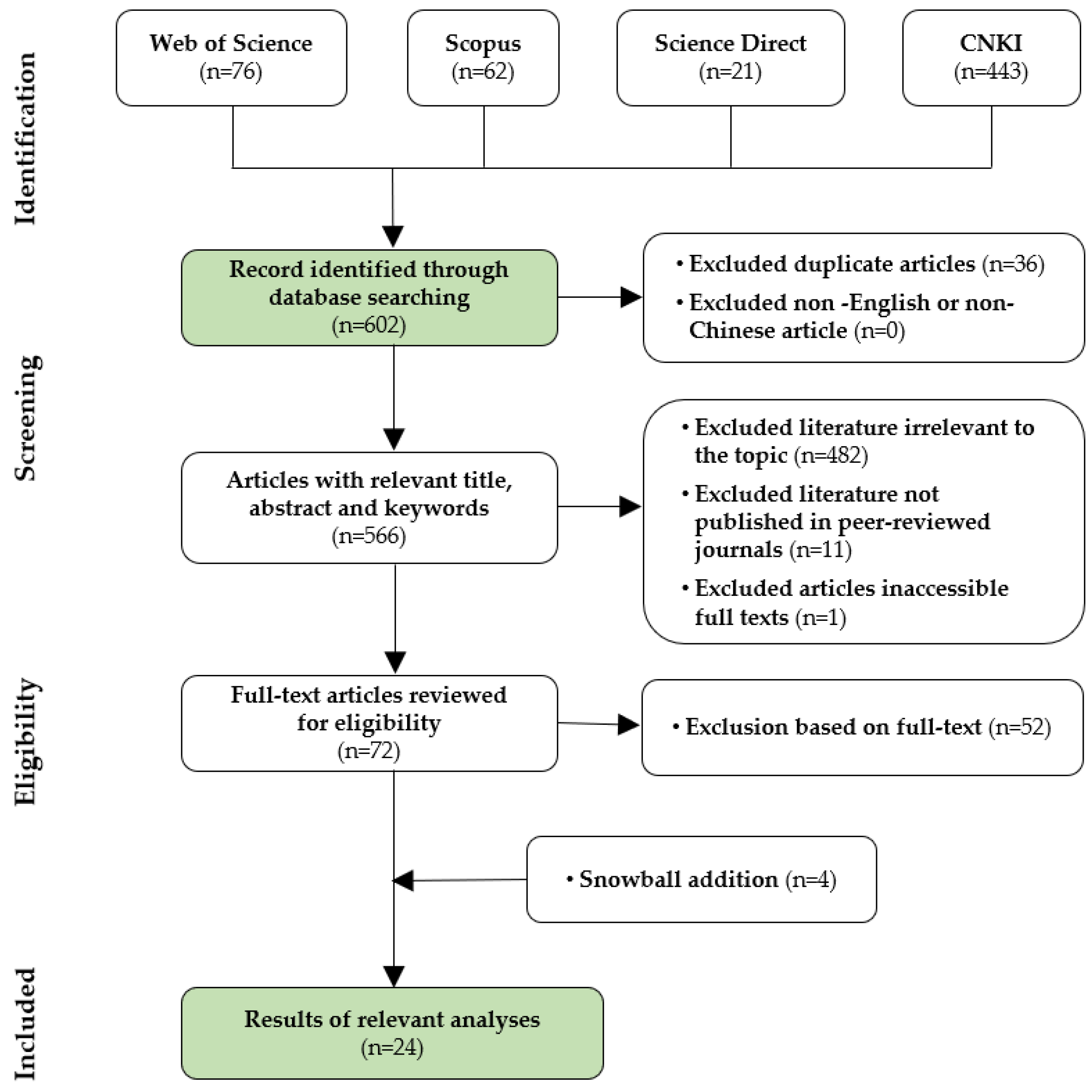

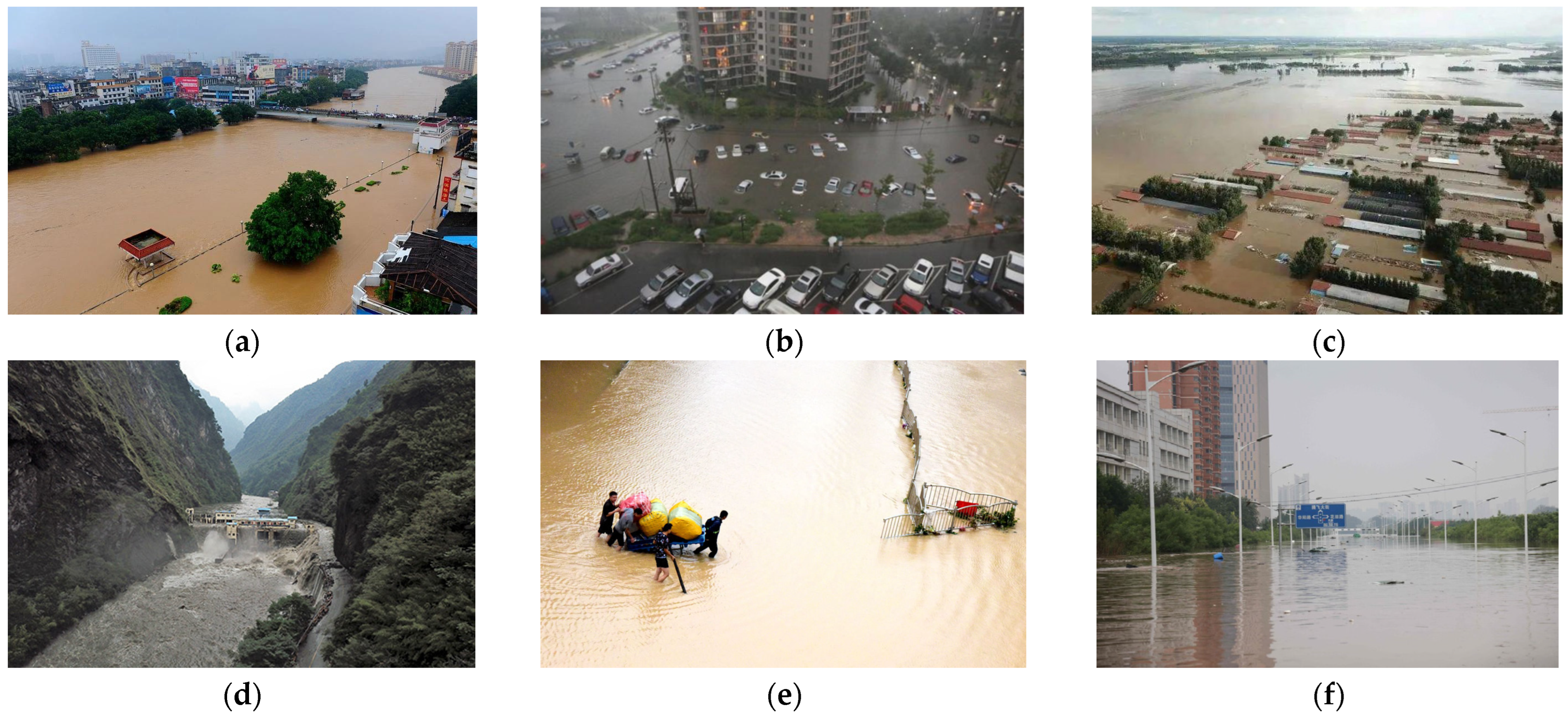
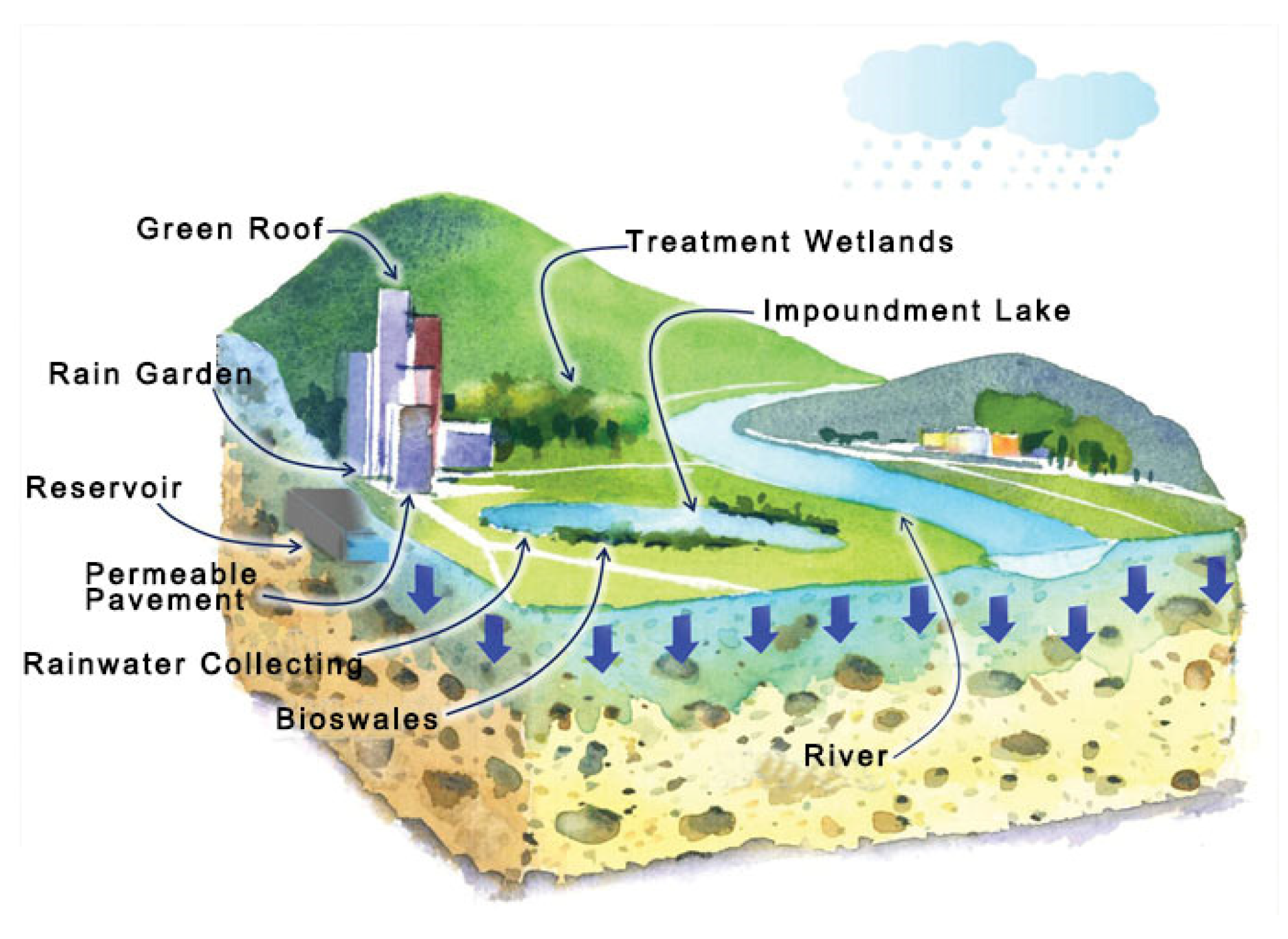
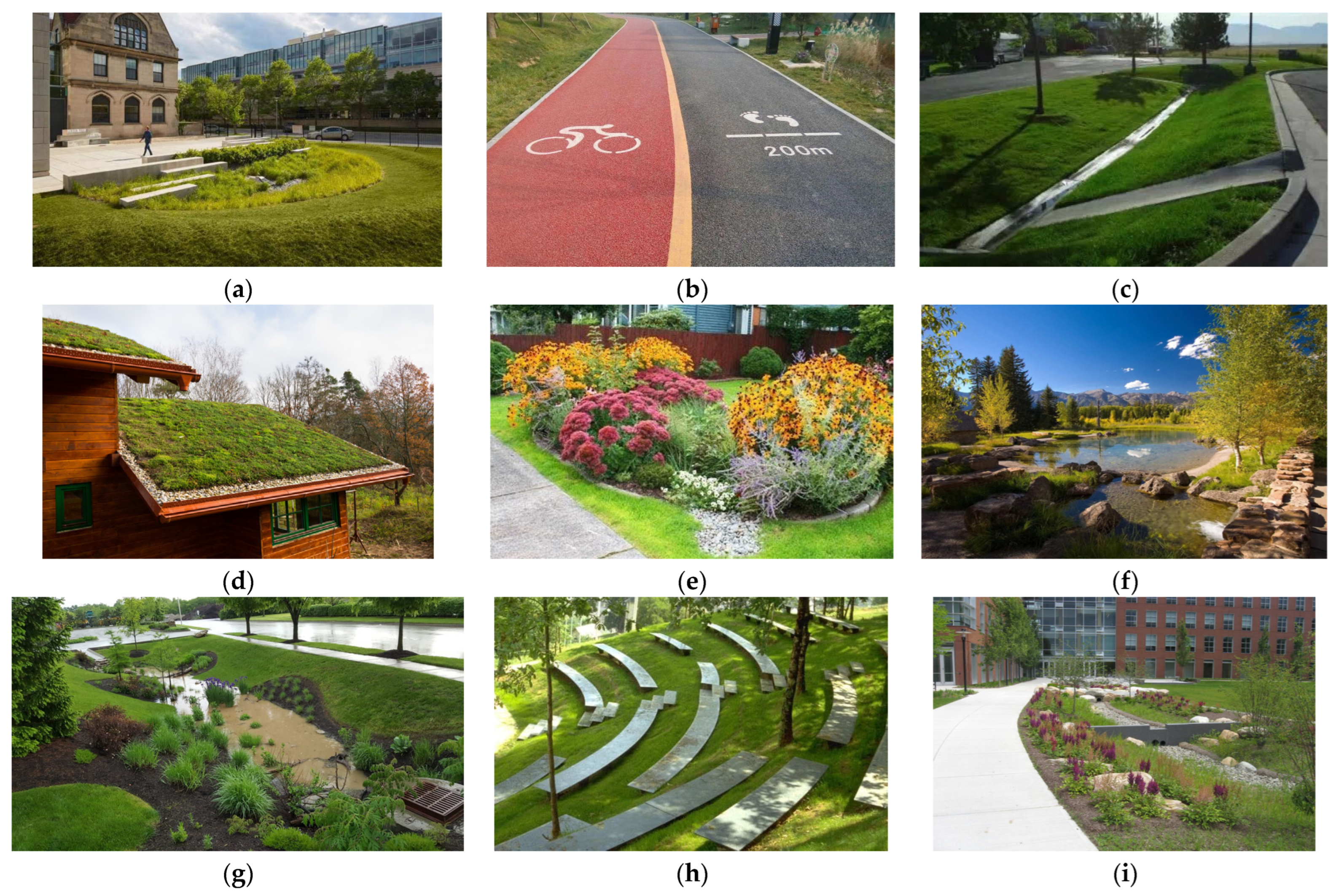
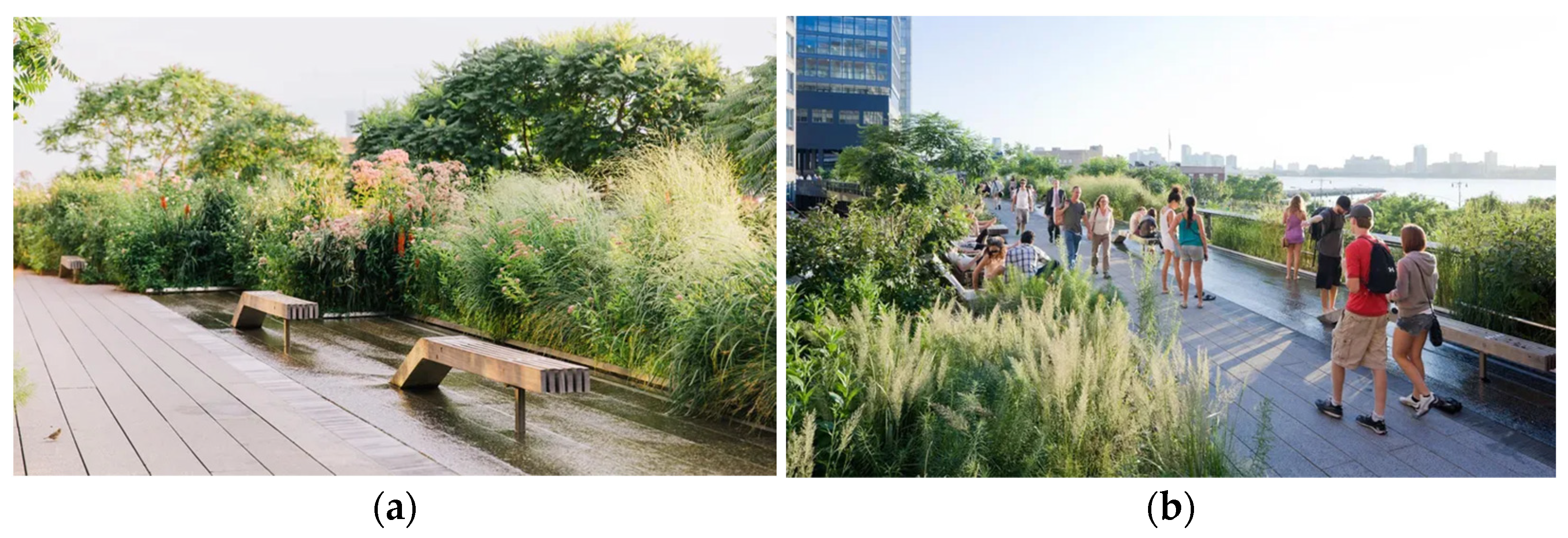

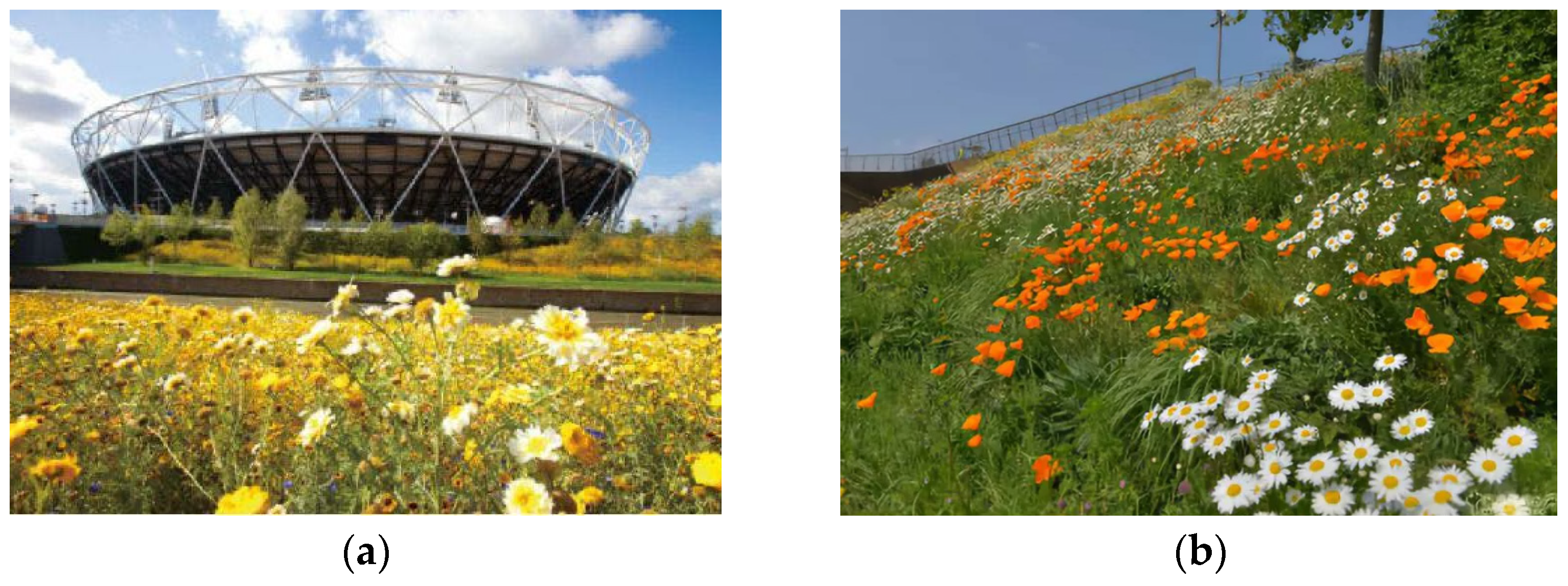
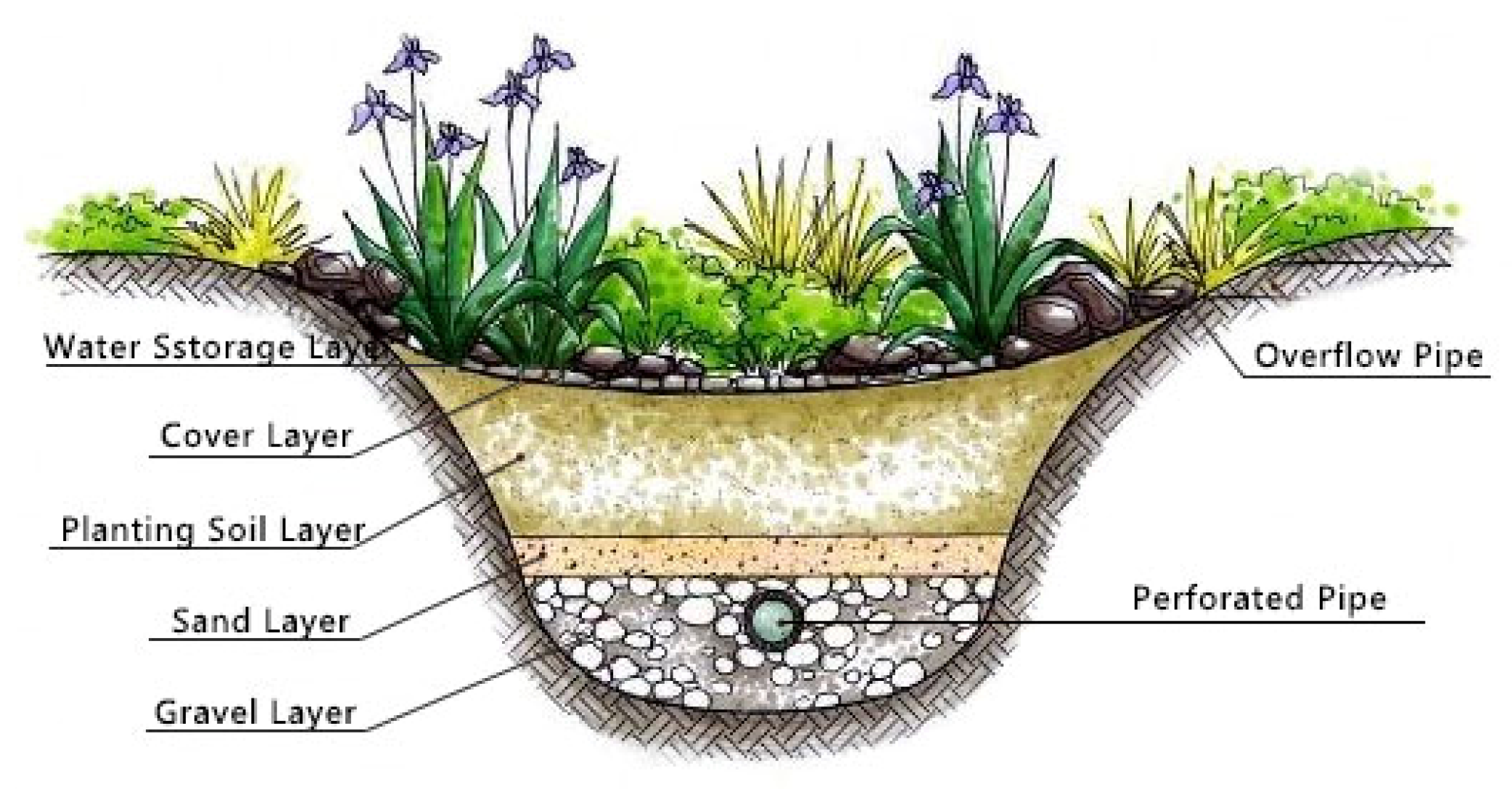
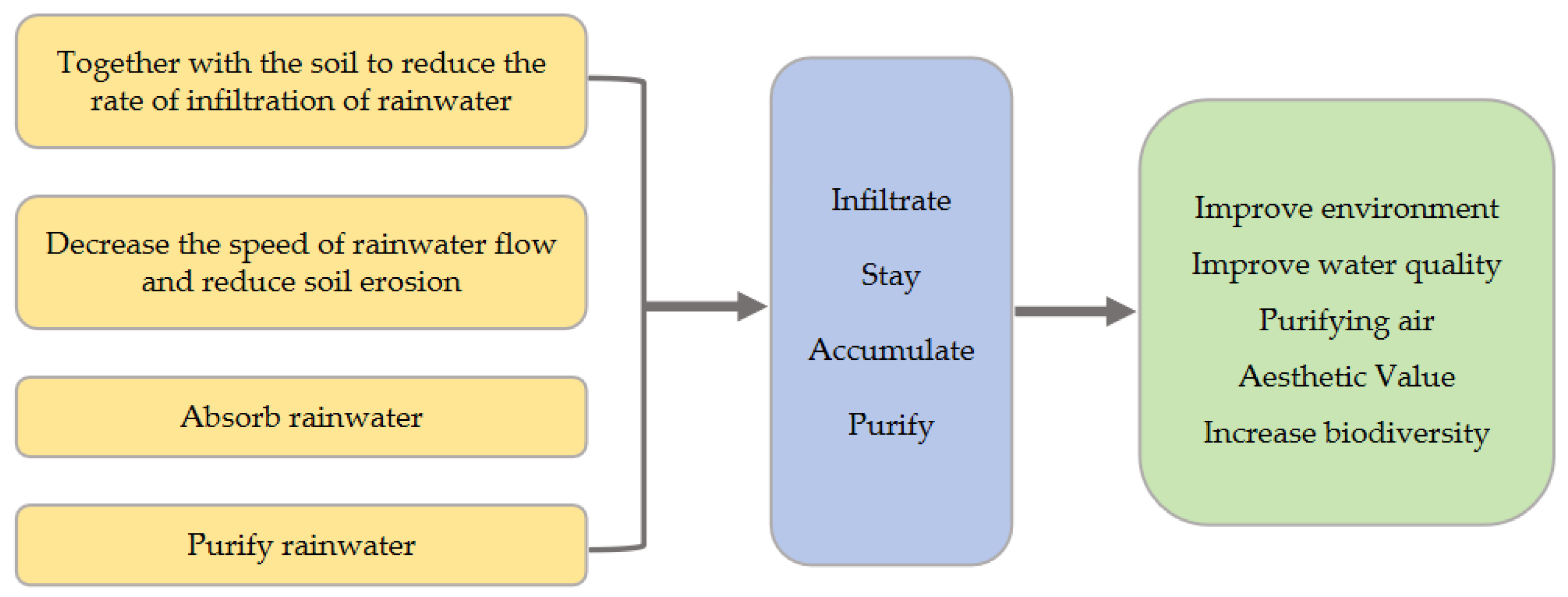


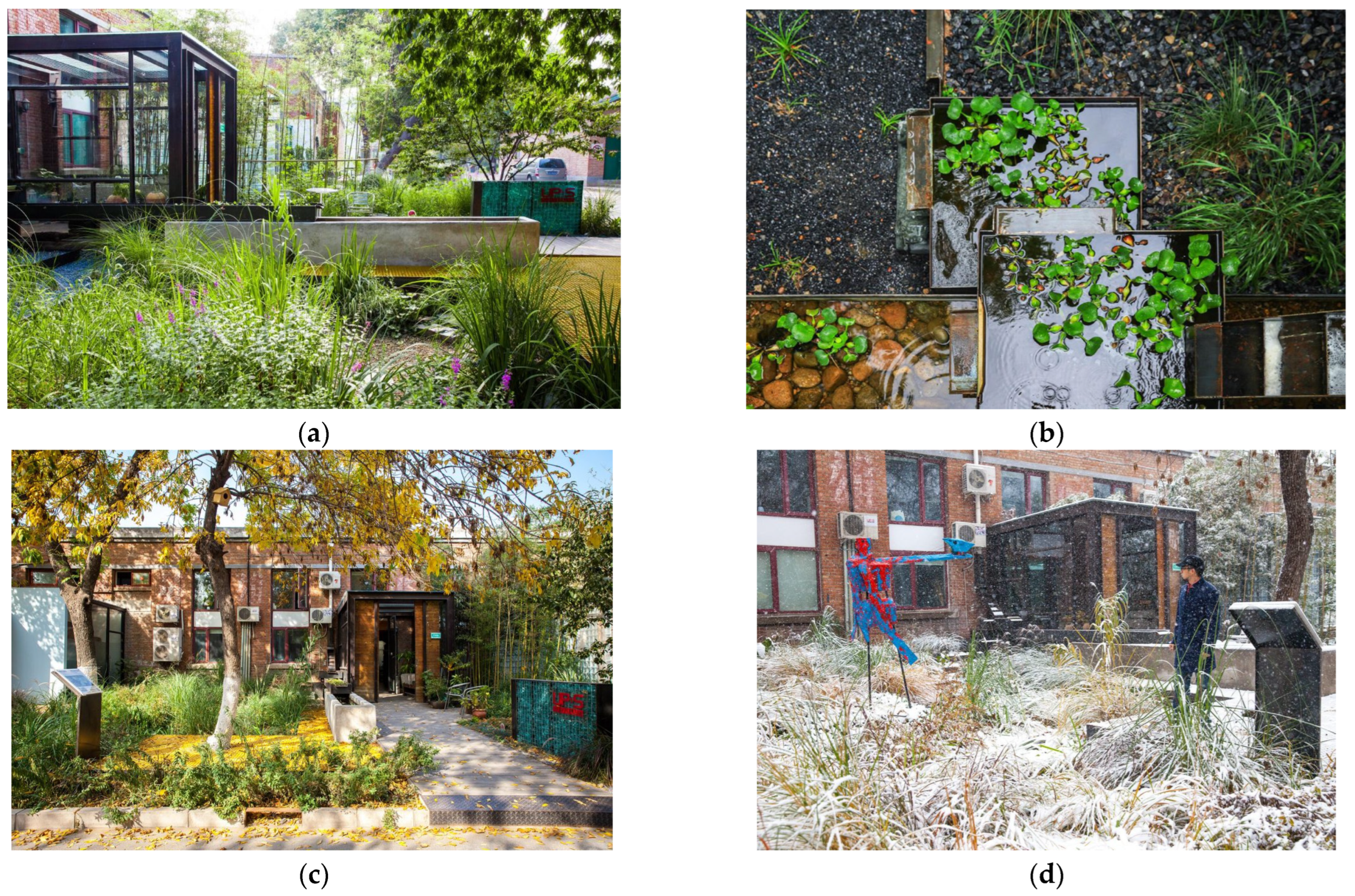
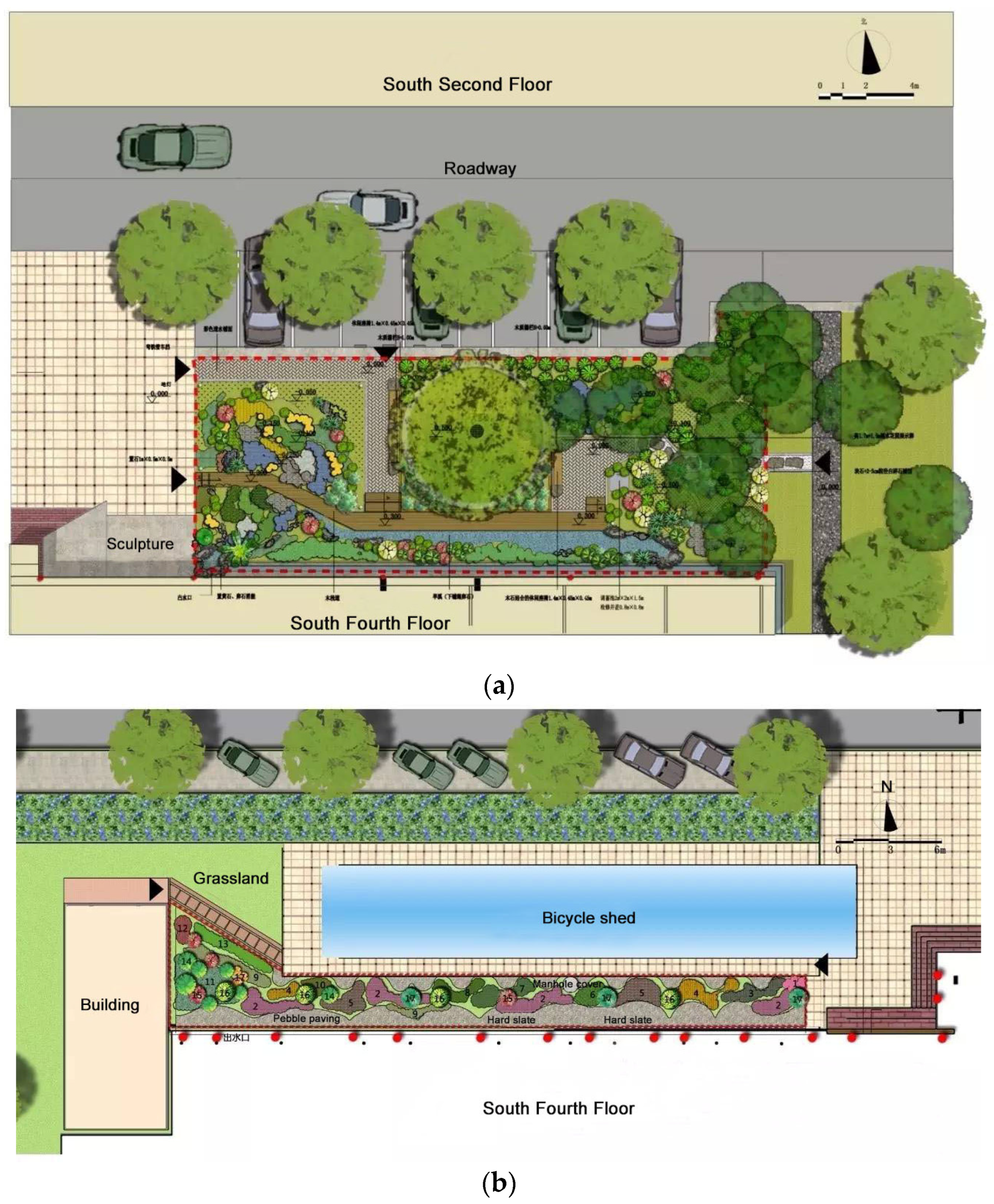

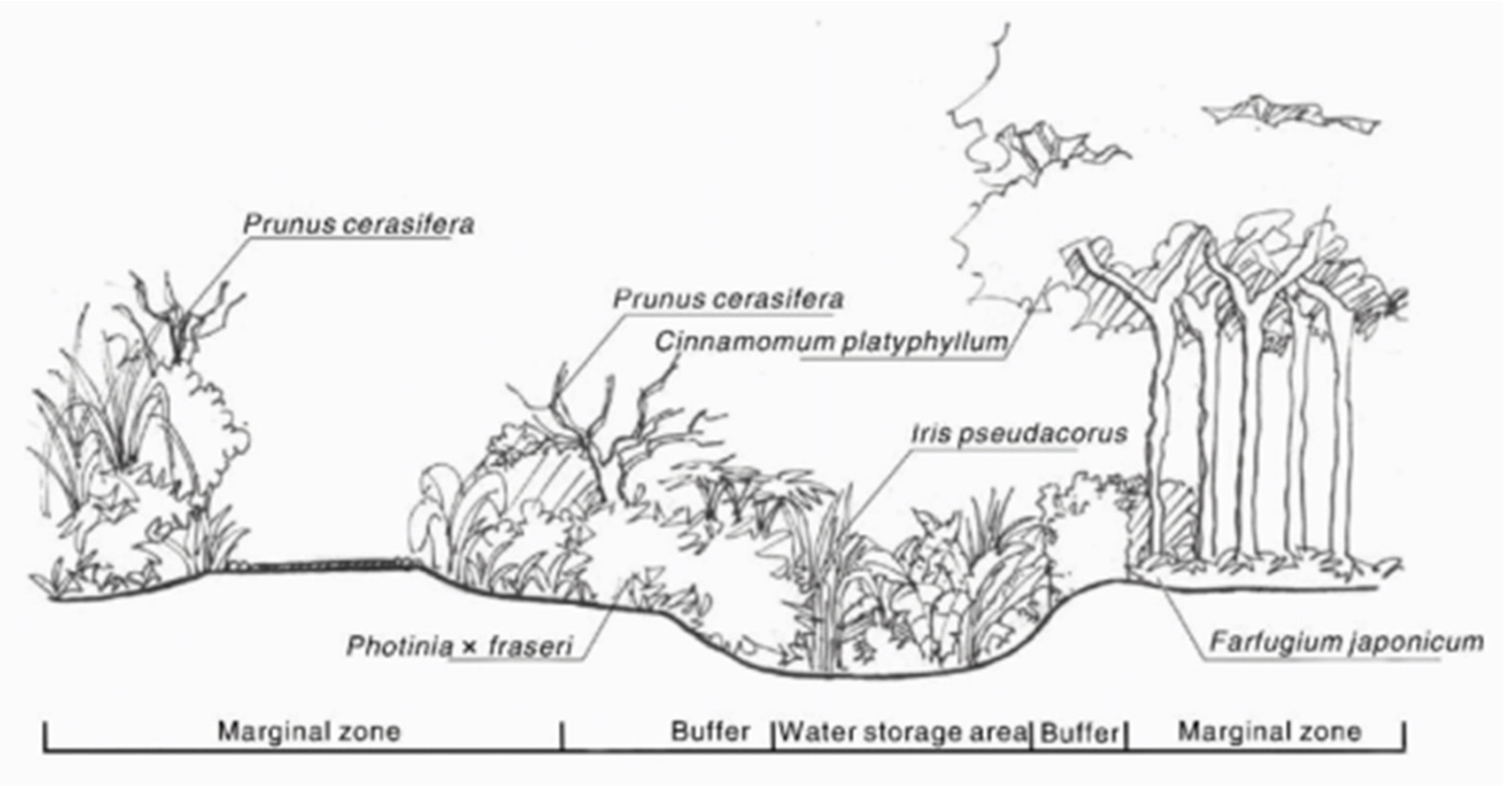
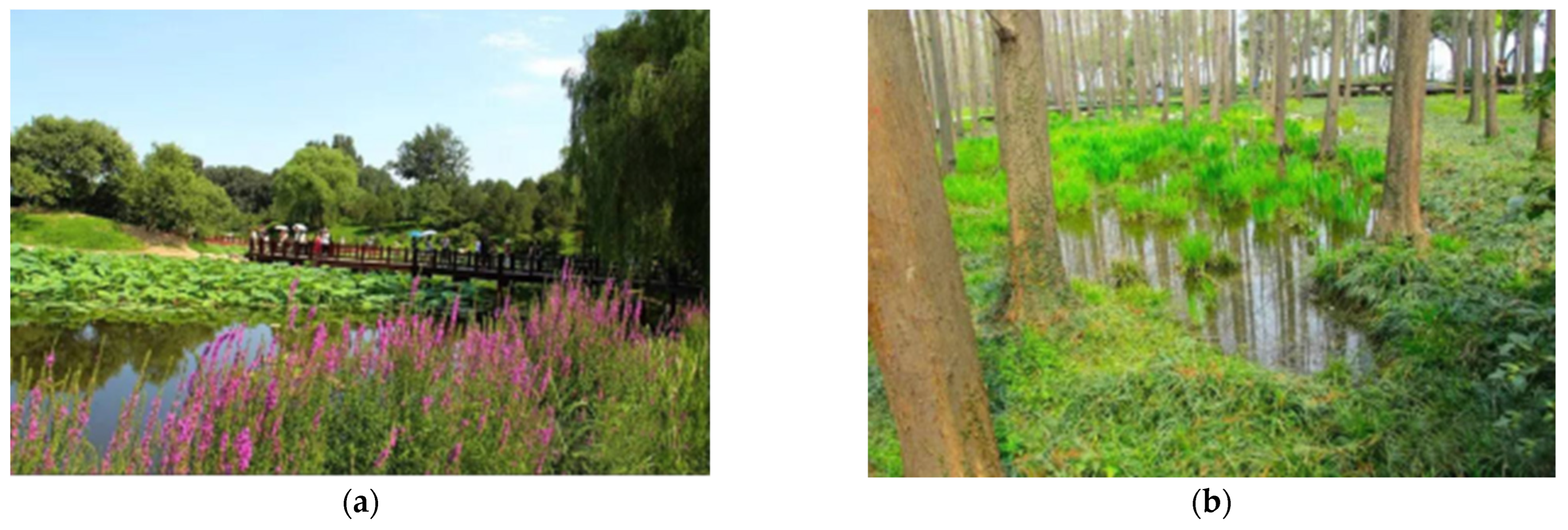



| Species | Number of Target Plants (Plants/m2) | The Number of Seed Needed (g/m2) | |
|---|---|---|---|
| Mixed seeds on low land slope | Betonica officinalis | 10 | 0.29 |
| Centaurea nigra | 10 | 0.13 | |
| Geranium sylvaticum | 10 | 0.67 | |
| Leucanthemum vulgare | 40 | 0.07 | |
| Lychnis flos-cuculi | 40 | 0.04 | |
| Cardamine pratensis | 50 | 0.19 | |
| Mixed seeds at bottom of basin | Geranium sylvaticum | 5 | 0.33 |
| Eupatorium cannabinum | 5 | 0.02 | |
| Lythrum salicaria | 5 | 0.00 | |
| Valeriana officinalis | 5 | 0.02 | |
| Mentha aquatica | 30 | 0.02 | |
| Juncus effusus | 30 | 0.00 | |
| Lychnis flos-cuculi | 40 | 0.04 | |
| Cardamine pratensis | 40 | 0.15 |
| Types | Species | Native or Non-Native | Height (cm) | Flowers’ Color | Flowering Time (Month) |
|---|---|---|---|---|---|
| Perennial herbs | Hosta plantaginea (Lam.) Aschers. | Native | 30~40 | White or purple | 8~9 |
| Iris tectorum Maxim. | 30~50 | Blue-purple or yellow | 4~6 | ||
| Clematis heracleifolia DC | 30~70 | Blue-purple | 8~9 | ||
| Potentilla chinensis Ser. | 20~70 | Yellow | 4~6 | ||
| Ranunculus japonicus Thunb. | ≤70 | Yellow | 4~6 | ||
| Lythrum salicaria L. | 30~100 | Magenta or lavender | 7~8 | ||
| Gaura lindheimeri Engelm. et Gray | ≤100 | Light blue-purple or white | 8~10 | ||
| Aster novi-belgii | 60~100 | White or light pink | 5~8 | ||
| Dianthus deltoids L. | Non-native | 15~40 | White, light yellow, pink, or red | 5~6 | |
| Sedum hybridum ‘Immergrunchett’ | 15~20 | White, fuchsia, or rose red | 6~10 | ||
| Allium | 40 | White, pink, purple, or yellow | 4~5 | ||
| Achillea millefolium | 40~100 | White, pink, or lavender | 7~9 | ||
| Physostegia virginiana | 60~120 | Light blue, fuchsia, or pink | 7~9 | ||
| Ornamental grasses | Carex giraldiana | Non-native | 16~30 | ||
| Pennisetum alopecuroides (L.) Spreng | 30~120 | ||||
| Calamagrostis epigeios (L.) Roth | 45~100 | ||||
| Pennisetum setaceum ‘Rubrum’ | 60~90 | ||||
| Miscanthus sinensis cv. | 100~200 | ||||
| Panicum virgatum | 100~200 | ||||
| Miscanthus sinensis Andress ‘Zebrinus’ | 120 | ||||
| Cortaderia selloana | 200~300 | ||||
| Arundo donax | 300~600 | ||||
| Aquatic herbs | Eichhornia crassipes (Mart.) Solms | Native | 30~60 | Blue-purple | 7~10 |
| Iris pseudacorus L. | Non-native | 60~100 | Yellow | 5 |
| Types | Species | Native or Non-Native | Height (cm) | Flowers’ Color | Flowering Time (Month) | Quantity |
|---|---|---|---|---|---|---|
| Perennial herbs | Gaura lindheimeri ‘Crimson Bunny’ | Native | 90~130 | Pink | 5~11 | 120 |
| Coreopsis grandiflora ‘Hogg’ | 20~100 | Yellow | 5~9 | 48 | ||
| Hydrangea macrophlla | 100~400 | Pink, light blue, or white | 6~8 | 5 | ||
| Trachelospernuim jasminoides ‘Flame’ | 20~50 | White or light pink | 5~8 | 50 | ||
| Hemerocallis fuava ‘Baltimore Oriole’ | Non-native | 40~50 | Red | 7~8 | 5 | |
| Hylotelephium erythrostictum | 30~50 | White, fuchsia, rose red | 7~10 | 100 | ||
| gm hybrida ‘Vbss’ | 10~50 | White, red, blue, snow green, or pink | 5~11 | 90 | ||
| Ornamental grasses | Miscanthus sinensis | Native | 100~200 | 18 | ||
| Carer ‘Evergold’ | Non-native | 20 | 30 |
| Types | Species | Native or Non-Native | Height (cm) | Flowers’ Color | Flowering Time (Month) |
|---|---|---|---|---|---|
| Perennial herbaceous flowers | Hemerocallis fulva | Native | 30~60 | Orange | 5~8 |
| Ophiopogon bodinieri | 10~30 | White or slightly purple | 6~8 | ||
| Canna indica | ≤150 | Red and yellow | 5~10 | ||
| Euryops pectinatus | 30~50 | Yellow | 5~7 | ||
| Iris germanica | 30~50 | Lavender, blue-purple, deep purple, or white | 4~5 | ||
| Lythrum salicaria L. | 30~100 | Magenta or lavender | 7~8 | ||
| Iris tectorum Maxim. | 30~50 | Blue-purple or yellow | 4~6 | ||
| Cordyline fruticosa | Non-native | 100~300 | Light red; blue-purple to yellow | 11~3 | |
| Digitalis purpurea | 60~120 | Fuchsia | 5~6 | ||
| Reineckea carnea | 20 | Lavender | 8~9 | ||
| Sedum lineare | 10~20 | Yellow | 4~5 | ||
| Ornamental grasses | Juncus setchuensis | Native | ≤90 | Brown | 6~9 |
| Cyperus alternifolius | 30~150 | White | 3 | ||
| Phalaris arundinacea | Non-native | 60~140 | Violet | 5~9 | |
| Nassella tenuissima | 30~50 | Yellow | 5 | ||
| Arundo donax ‘Versicolor’ | 300~600 | Blue-purple | 7~10 | ||
| Aquatic herbs | Sagittaria sagittifolia | Native | 60~100 | ||
| Ceratophyllum demersum | 40~150 | ||||
| Typha orientalis Presl | 130–200 | ||||
| Gladiolus gandavensis | 30~60 | ||||
| Phragmites australi | 100~300 | ||||
| Vallisneria natans | 20~200 | ||||
| Typha angustifolia | ≤300 | ||||
| Lemna minor | 3~4 | ||||
| Nymphaea tetragona | 80~150 | ||||
| Iris pseudacorus L. | Non-native | 60~100 | Pink or white | 7~10 | |
| Nuphar pumila | 40~50 | ||||
| Thalia dealbata | 100~250 | Yellow | 5~7 |
| Types | Species | Native or Non-Native | Height (cm) | Flowers’ Color | Flowering Time (Month) |
|---|---|---|---|---|---|
| Perennial herbaceous flowers | Lythrum salicaria L. | Native | 30~100 | Magenta or lavender | 7~8 |
| Iris tectorum Maxim. | 30~50 | Blue-purple or yellow | 4~6 | ||
| Orychophragmus violaceus (L.) O. E. Schulz | 50 | Purple | 4~5 | ||
| Ophiopogon japonicus (Linn. f.) Ker-Gawl. | 20~50 | White or lavender | 5~8 | ||
| Echinacea purpurea (Linn.) Moench | 50~150 | White | 6~8 | ||
| Rosmarinus officinalis | Non-native | 200 | Blue-purple | 11 | |
| Ornamental grasses | Reineckea carnea var. varigata | Native | 20 | ||
| Juncus setchuensis | ≤90 | ||||
| Pennisetum alopecuroides (L.) Spreng | 30~120 | ||||
| Miscanthus sinensis cv. | 100~200 | ||||
| Aquatic herbs | Iris pseudacorus L. | Non-native | 60~100 | Yellow | 5 |
Disclaimer/Publisher’s Note: The statements, opinions and data contained in all publications are solely those of the individual author(s) and contributor(s) and not of MDPI and/or the editor(s). MDPI and/or the editor(s) disclaim responsibility for any injury to people or property resulting from any ideas, methods, instructions or products referred to in the content. |
© 2024 by the authors. Licensee MDPI, Basel, Switzerland. This article is an open access article distributed under the terms and conditions of the Creative Commons Attribution (CC BY) license (https://creativecommons.org/licenses/by/4.0/).
Share and Cite
Shi, L.; Maruthaveeran, S.; Yusof, M.J.M.; Zhao, J.; Liu, R. Exploring Herbaceous Plant Biodiversity Design in Chinese Rain Gardens: A Literature Review. Water 2024, 16, 1586. https://doi.org/10.3390/w16111586
Shi L, Maruthaveeran S, Yusof MJM, Zhao J, Liu R. Exploring Herbaceous Plant Biodiversity Design in Chinese Rain Gardens: A Literature Review. Water. 2024; 16(11):1586. https://doi.org/10.3390/w16111586
Chicago/Turabian StyleShi, Lin, Sreetheran Maruthaveeran, Mohd Johari Mohd Yusof, Jing Zhao, and Ruosha Liu. 2024. "Exploring Herbaceous Plant Biodiversity Design in Chinese Rain Gardens: A Literature Review" Water 16, no. 11: 1586. https://doi.org/10.3390/w16111586
APA StyleShi, L., Maruthaveeran, S., Yusof, M. J. M., Zhao, J., & Liu, R. (2024). Exploring Herbaceous Plant Biodiversity Design in Chinese Rain Gardens: A Literature Review. Water, 16(11), 1586. https://doi.org/10.3390/w16111586






